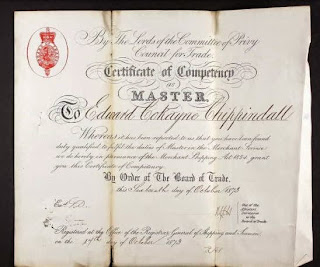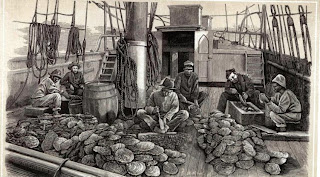Edward
Cockayne Chippindall was born in 1853 in a small village in Staffordshire. His
father – the Reverend John Chippindall was Rector of St Luke’s in Cheetham Hill
for many years. His grandfather was described as “Clerk; MA – Occupation:
Esquire”. Edward, born into this middle class, comfortable family in rural
England in the 1850s, was an incredible man. He served in the Navy, endured
shipwrecks, disease , cannabilism, a trial for manslaughter and appalling conditions
in a harsh, unforgiving country thousands of miles from home. In today’s
parlance, he had been on an amazing and almost unbelievable journey. A
man who took great risks, that finally cost him his life. A true Victorian
explorer but one who almost no-one has ever heard of! I hope this article
serves as a memorial to his fortitude.
Early
Life
In 1861,
Edward was living at Dale End, Warslow, Staffordshire where his father was the
incumbent of the church. By the time of the 1871 census, while his family were
in Cheetham Hill, he was a midshipman aboard the Eclipse in the Royal Navy but
by the end of the year he had been promoted to a Sub Lieutenant. I have found a
Certificate of Competency as a Master of the Merchant Navy for him in 1873,
from the Port of Liverpool.
A Life of
Adventure Begins!
After
this fairly “ordinary” even mundane, middle class, start in life, things
swiftly become rather more exciting, if more challenging to track! There is no
mention of him that I can find from the time he got his Captain status until
1880, although, piecing together other information I have found for him, I
think that from 1873, he became involved with one Captain Thomas Haynes (whose
occupation was rather thrillingly described as “explorer” on his daughter’s
wedding certificate!) Thomas played a big part in this story as we shall see
later, to the extent of being buried next to Edward in a remote cemetery in
Australia, even though he died many years after Edward and in England, having
raised 7 children and with a wife still alive.
According
to a report in the Lancaster Gazette dated 4th September 1880,
Edward was now in Fiji, where he was tried for the manslaughter of a “native” ,
the accusers being disaffected labourers. Indeed, according to the report, the
natives were taking on ”all the vices of the settlers” and “the only
improvement in their behaviour has been their cessation of cannibalism”. A far
cry from Cheetham Hill indeed! I have found several articles and a heartfelt
plea in the press from his loyal, (and somewhat tolerant!) father, the
highly regarded Reverend John Chippindall, saying that the charges had
been made up by the Governor of Fiji, Sir Arthur Gordon. Edward had
somehow become entangled in a dispute of some kind with him. The Reverend
gave a glowing picture of how Edward and the Captain had treated the local
natives with great respect and had helped to improve their living conditions.
The Magistrates in Fiji agreed with these sentiments and threw the case out.
What a worry this must have been to his relatives far away in Manchester.
At the
time of the 1881 census taken in April of that year, Edward is back with his
family in Manchester, but described as a Sub Lieutenant in the Royal Navy,
although I do not believe he had served in the Navy for some time. Maybe he had
been ordered to return home after his earlier escapades. After all, he is not
yet 30 years of age but has already given his family plenty to worry about!
Indeed
Edward is involved in yet another catastrophe later in the year. He is
mentioned in connection with a shipping disaster in July of that year when the Zara, a
ship he commanded, was wrecked on the way from Table Bay in Australia to Fiji.
This ship had actually once been owned by the Prince of Wales, according to
newspaper reports, but was now owned by our doughty Captain Haynes. Although
Edward managed to save the crew, the ship was beached but then broke up.
Adventures
in Paradise
I have
found a digitalised book “Pearls and Pearling Life” by Edward Streeter dated
1886 which gives an incredibly detailed account of these times. Edward and the
Captain are shown to be heavily involved in the pearl fishing industry in
Australia and the islands. Edward Streeter was a jeweller from Hatton
Garden, London. He funded their exploration in far off islands and colonies. He
said that the pair faced many perils, including insurrection by natives and
pearl fishermen , to the extent that there was a mutiny.There were several
incidences of illnesses (their ship, the Sree Pas Sair
was once described as a “charnel house” ) and at least one occasion when, on
venturing to land on a small island, they were surrounded by “100s of canoes
with armed savages in them”. There is no explanation as to how they
managed to escape from this somewhat dangerous encounter!
The
finest and most complete pearling vessel afloat is the “Sree Pas-Sair,” (“The
Belle of Pas-Sair,” a district in Borneo), a brigantine of 112 tons, bought and
equipped by the late Mr. E. C. Chippindall, R.N., at the expense of the author
(Mr Streeter)
And so,
we finally arrive at Broome Bay, where Edward met his death and was to be
buried in 1886.
Death In
Paradise
From
various newspaper reports and accounts, Captain Haynes and Edward worked in the
pearl fishing industry in Western Australia and various islands from at least
1881, when Edward was involved in the shipwreck of the Zara.
There is a lot of information online about this period and it would seem that
at least initially, the men lived in conditions similar to the early settlers,
living in tents and makeshift buildings, with various “temptations” for the men
who lived and worked there such as brothels and drinking houses.
“Broome
is an affluent, sinful and tolerant community in which the Clergy’s frequent references to Sodom and
Gomorrah are regarded as appropriate tributes to civic progress rather
than as warnings of future divine retribution. ”
H.V. Howe, Pearler
I don’t
know how this lifestyle would have been greeted back in the Reverend’s parish
of Cheetham Hill!
Notwithstanding
the dubious pleasures of the pearling community, Edward was making
excellent progress in the industry and was very highly regarded by many,
including Mr Streeter of Hatton Garden, who stated that “the finest, largest
pearl ever seen” was found by Edward Chippindall while pearling on the
Sree Par Sair on Christmas Day 1884. It weighed 40 grams and was
“absolutely round”. Edward and the Captain continued to explore and expand the
industry; one report states they owned 2 schooners and 11 luggers.
However,
tragedy struck Edward whilst he was onboard the schooner Telephone.
I have found a report in a Western Australian newspaper that states that he
died of “brain fever” on 22nd May 1886 while at sea and he was
brought back and interred in the aptly named Pioneer Cemetery, Broome
Bay, Australia, which is located on a small, isolated, grassed promontory
overlooking Roebuck Bay and near the site of the Old Jetty.
The actual cemetery
area is surrounded by a number of well established trees and is very peaceful..
One can only imagine the heartbreak for the 34 year old’s family when they
heard the news back in England. I have found a notice in their local paper
which advises that a memorial to Edward was placed in the church where his
father had preached for many years.
Incidentally,
the intrepid explorer, Captain Haynes, continued to work in Australia for many
years, but obviously returned home to England from time to time, as he fathered
7 children! He is on a trip home in 1901 for the census and his occupation is
“railway contractor and director of companies”. He died in 1929 in England,
aged 76 leaving a large amount of money (£16,600) , so his various ventures had
been very successful. However, there is one more twist to the story. Even
though his 7 children and his wife were still alive when he died, his remains
were shipped to that isolated pioneers’ cemetery, where he was laid to
rest next to his friend and partner, Edward Cockayne Chippindall ,
together once more. Did the Captain’s or Edward’s family ever travel half way
across the world to visit them once more, resting under the trees and
overlooking the ocean in their final resting place? We shall never know.



No comments:
Post a Comment